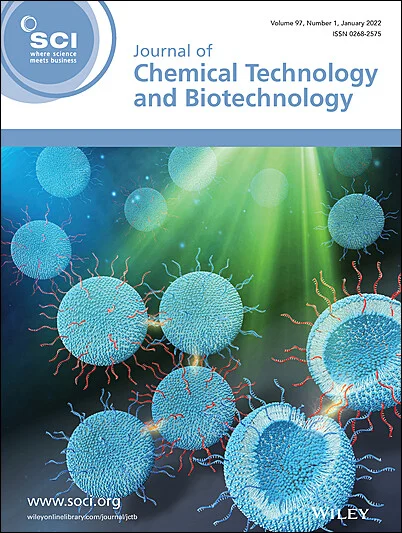求助PDF
{"title":"不同制备方法催化双功能生物炭协同热解松木锯屑和低密度聚乙烯生产富含芳香烃的油类","authors":"Haonnan Qiao, Yaqi Feng, Changsen Zhang","doi":"10.1002/jctb.7656","DOIUrl":null,"url":null,"abstract":"<div>\n \n \n <section>\n \n <h3> Background</h3>\n \n <p>Catalytic co-pyrolysis of biomass with waste plastics can produce high-quality chemicals, making it a potential alternative to fossil fuels. The production of aromatic-rich oil was achieved in this work by the catalytic co-pyrolysis of pine sawdust and low-density polyethylene (LDPE) using a series of biochar (BC) made using different preparation methods. Zinc chloride (ZnCl<sub>2</sub>) was employed to activate the BC during the preparation process, owing to its optimal activity for the co-pyrolysis intermediates. The study compared the effects of BCs activated using different treatment methods on the yield and fractions of pine sawdust and LDPE co-pyrolysis in a fast pyrolysis tube furnace at 650 °C.</p>\n </section>\n \n <section>\n \n <h3> Results</h3>\n \n <p>The study indicates that the ZnCl<sub>2</sub> BC, prepared from pine sawdust by fast pyrolysis (F-AC), exhibited the best aromatic catalytic activity. The selectivity to aromatic hydrocarbons was 72.53%, and the content of BTEX (benzene, toluene, ethylbenzene, and xylene) was 32.17%.</p>\n </section>\n \n <section>\n \n <h3> Conclusion</h3>\n \n <p>The Diels–Alder reaction and aromatization were made more effective due to the Zn sites and large pore structure in F-AC. Using Fourier transform infrared, scanning electron microscopy and X-ray photoelectron spectroscopy analysis, it was found that F-AC contained more oxygen (O)-containing groups in abundance, which improved its adsorption capacity for reaction intermediates. At the same time, the porous structure and high SSA of BC provided a region for the reaction intermediate to interact with the active center containing O-containing groups. This enhanced the synergy between biomass and plastics and raised the selectivity of aromatic hydrocarbons. It provides a reference for the application of carbon-based materials in the co-pyrolysis of biomass and waste plastics. © 2024 Society of Chemical Industry (SCI).</p>\n </section>\n </div>","PeriodicalId":15335,"journal":{"name":"Journal of chemical technology and biotechnology","volume":"99 7","pages":"1626-1636"},"PeriodicalIF":2.8000,"publicationDate":"2024-04-15","publicationTypes":"Journal Article","fieldsOfStudy":null,"isOpenAccess":false,"openAccessPdf":"","citationCount":"0","resultStr":"{\"title\":\"Aromatic-rich oil production from catalytic co-pyrolysis of pine sawdust and LDPE with bifunctional biochar by different preparation methods\",\"authors\":\"Haonnan Qiao, Yaqi Feng, Changsen Zhang\",\"doi\":\"10.1002/jctb.7656\",\"DOIUrl\":null,\"url\":null,\"abstract\":\"<div>\\n \\n \\n <section>\\n \\n <h3> Background</h3>\\n \\n <p>Catalytic co-pyrolysis of biomass with waste plastics can produce high-quality chemicals, making it a potential alternative to fossil fuels. The production of aromatic-rich oil was achieved in this work by the catalytic co-pyrolysis of pine sawdust and low-density polyethylene (LDPE) using a series of biochar (BC) made using different preparation methods. Zinc chloride (ZnCl<sub>2</sub>) was employed to activate the BC during the preparation process, owing to its optimal activity for the co-pyrolysis intermediates. The study compared the effects of BCs activated using different treatment methods on the yield and fractions of pine sawdust and LDPE co-pyrolysis in a fast pyrolysis tube furnace at 650 °C.</p>\\n </section>\\n \\n <section>\\n \\n <h3> Results</h3>\\n \\n <p>The study indicates that the ZnCl<sub>2</sub> BC, prepared from pine sawdust by fast pyrolysis (F-AC), exhibited the best aromatic catalytic activity. The selectivity to aromatic hydrocarbons was 72.53%, and the content of BTEX (benzene, toluene, ethylbenzene, and xylene) was 32.17%.</p>\\n </section>\\n \\n <section>\\n \\n <h3> Conclusion</h3>\\n \\n <p>The Diels–Alder reaction and aromatization were made more effective due to the Zn sites and large pore structure in F-AC. Using Fourier transform infrared, scanning electron microscopy and X-ray photoelectron spectroscopy analysis, it was found that F-AC contained more oxygen (O)-containing groups in abundance, which improved its adsorption capacity for reaction intermediates. At the same time, the porous structure and high SSA of BC provided a region for the reaction intermediate to interact with the active center containing O-containing groups. This enhanced the synergy between biomass and plastics and raised the selectivity of aromatic hydrocarbons. It provides a reference for the application of carbon-based materials in the co-pyrolysis of biomass and waste plastics. © 2024 Society of Chemical Industry (SCI).</p>\\n </section>\\n </div>\",\"PeriodicalId\":15335,\"journal\":{\"name\":\"Journal of chemical technology and biotechnology\",\"volume\":\"99 7\",\"pages\":\"1626-1636\"},\"PeriodicalIF\":2.8000,\"publicationDate\":\"2024-04-15\",\"publicationTypes\":\"Journal Article\",\"fieldsOfStudy\":null,\"isOpenAccess\":false,\"openAccessPdf\":\"\",\"citationCount\":\"0\",\"resultStr\":null,\"platform\":\"Semanticscholar\",\"paperid\":null,\"PeriodicalName\":\"Journal of chemical technology and biotechnology\",\"FirstCategoryId\":\"5\",\"ListUrlMain\":\"https://onlinelibrary.wiley.com/doi/10.1002/jctb.7656\",\"RegionNum\":4,\"RegionCategory\":\"生物学\",\"ArticlePicture\":[],\"TitleCN\":null,\"AbstractTextCN\":null,\"PMCID\":null,\"EPubDate\":\"\",\"PubModel\":\"\",\"JCR\":\"Q3\",\"JCRName\":\"BIOTECHNOLOGY & APPLIED MICROBIOLOGY\",\"Score\":null,\"Total\":0}","platform":"Semanticscholar","paperid":null,"PeriodicalName":"Journal of chemical technology and biotechnology","FirstCategoryId":"5","ListUrlMain":"https://onlinelibrary.wiley.com/doi/10.1002/jctb.7656","RegionNum":4,"RegionCategory":"生物学","ArticlePicture":[],"TitleCN":null,"AbstractTextCN":null,"PMCID":null,"EPubDate":"","PubModel":"","JCR":"Q3","JCRName":"BIOTECHNOLOGY & APPLIED MICROBIOLOGY","Score":null,"Total":0}
引用次数: 0
引用
批量引用

 求助内容:
求助内容: 应助结果提醒方式:
应助结果提醒方式:


